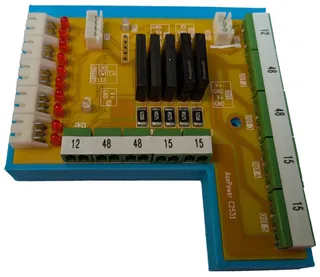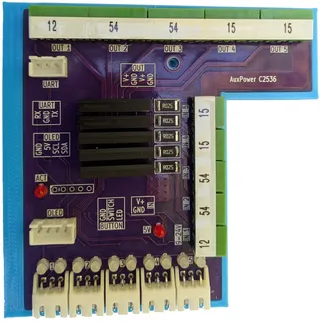The New Controller
With the new case sorted out, I decided onto a new power supply controller. Since I recently ended in the possesion of a few PhotoMOS device, I figured to check them out. While my own high-voltage MOSFET switching does work, there is no real isolation between my control circuit and the output voltage. PhotoMOS brings that additional safety.
Changing to AQZ202G PhotoMOS required a major PCB redesign. Fortunately, controlling PhotoMOS was trivial and thus most of time was just figuring how to lay things out without changing PCB size. After hours of “playtime” in KiCad, I sent the new PCB toward PCBWay to manufacture.
Once I got my boards back, I decided to first test it with a cheaper CPC1706Y PhotoMOS. I though yhe only difference between Littelfuse and Panasonic ones was the maximum current. Panasonic supported 6A (which I needed for my 65W PC connectivity) while Littelfuse PhotoMOS supported 4A. Since my fist three power channels were low wattage, I opted to use CPC1706Y for them, reserving AQZ202G for the channel 4 and 5.
And all channels worked flawlessly. Heck, channels CPC1706Y worked even when they were supposed to be off. At first I though it was due to firmware changes I did. But, an embarassing amount of troubleshooting later, I noticed that there is one more difference between Panasonic and Littelfuse. Panasonic uses bidirectional MOSFET switch. Littelfuse does not.
That means that Panasonic doesn’t really care which connection is more positive. And, since I used Panasonic to create KiCAD footprint, I opted for easier routing. But Littelfuse cared which connection is more positive and I selected wrong. Well, after another hour or two of moving traces around I was ready for another go.
Since PCBWay has an action going on where you could get a purple PCB for no extra change, I decided to try it out. And, while coloring PCB is a gimmick without impact to electrical design, over time I grown to appreciate it. With PCBWay offering multiple colors, I always alternate them between orders allowing for easier distinguishing between revisions. It’s way easier to tell whether PCB is purple or yellow at a glance, than if revision is C2531 or C2536.
Combinination of purple PCB and white silkscreen is a really a classical one in a hobbyist circles and PCBWay doesn’t disappoint here. While it is slightly lighter shade of purple than OSHPark, solder mask is of equally same high quality. It handled my clumsy soldering like a champ. :)
All in all I am mostly happy with the new PhotoMOS solution. As compared to my MOSFET switching it offers way better isolation from the rest of my circuit. Heat is about the same which is not surprising. However, when it comes to cost, there is really no competition. Darn PhotoMOS devices are EXPENSIVE. If price is a major consideration, it’s a no-brainer to roll-your-own.
For my AuxPower1U controller, I think I am going to stick with PhotoMOS. They do offer isolation and they are much easier to control. And, since this project is not cheap due to quite expensive power supplies, increase in cost is bearable.

